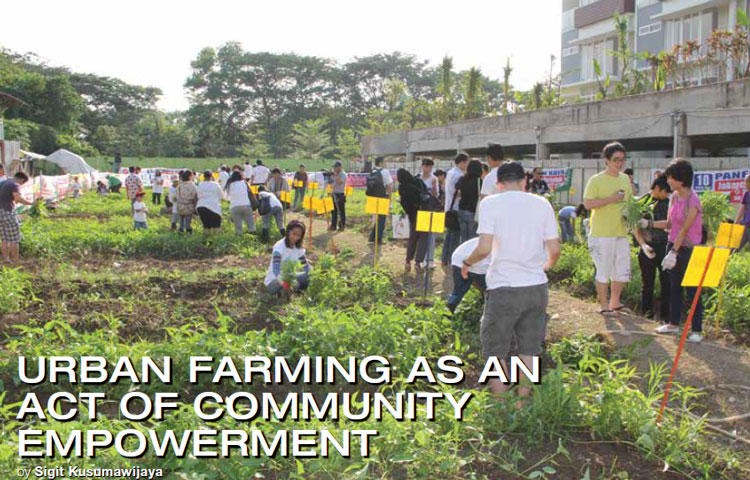
URBAN FARMING AS AN ACT OF COMMUNITY EMPOWERMENT
by Sigit Kusumawijaya
INTRODUCTION
The world’s population hit more than 7 billion people in 2011, and is expected to grow to about 9 billion by 2050. This will inevitably require an increase in demand for residential land and food. In the large cities, the focus is clearly on the development of residential and business areas, with the incessant demand for real estate, apartments and commercial areas. On the other hand, agricultural land in rural areas is facing more difficulties in terms of growth. This is exacerbated by the condition of forestry and agricultural land in the suburbs that has been converted to residential and/or industrial areas. As a result, productive farmland is decreasing and a pending food crisis is expected in the near future.
A change in land management concept for sustainable urban life is needed. Thus, the concept of agriculture intensification was created. It is expected to be the proper method to solve the food/land problem, by increasing the productivity of land and water resources in food production, animal husbandry, forestry and aquaculture. It could be said that this method is an attempt to optimise the limited land to be more productive and better able to provide food security. One of the ways is through urban agriculture, or often known as urban farming.
URBAN FARMING
Pedro Albizu, a pioneer in urban farming in Paseo Boricua, Chicago, USA, revealed that urban farming is a local practice for development and distribution, which naturally connects people to one another and also to their environment in ways that are participatory, democratic and fair. Local food production will increase food security and develop sustainable communities.
According to the Resource Centre on Urban Agriculture and Forestry (RUAF) Foundation located in the Netherlands, there are eight systems of urban farming production:
1. Micro farming inside and around the house
2. Community gardening
3. Institutional-scale urban agriculture
4. Small-scale commercial horticulture
5. Commercial farms in small-scale and aquatic farms
6. Specific urban agriculture and forestry production
7. Large-scale agrobusiness
8. Multifunctional agriculture
RUAF Foundation also categorises the types of urban farming locations, namely:
1. In the city or in the peri-urban areas, including house and yard (above plot)
2. Vacant land away from residential area, private land, public land such as parks, side roads, railways, as well as semi-public land
3. Land such as school area, hospital area and other institutions
To read the complete article, get a copy of the Mar-Apr 2013 edition at our online shop or at newsstands/major bookstores; or subscribe to FuturArc.
Published by FutureArc.com on Mar-Apr 2013
Link: http://www.futurarc.com/index.cfm/editorial/commentary/2013-mar-apr-commentary-urban-farming-as-an-act-of-community-empowerment/
Link: http://www.futurarc.com/index.cfm/editorial/commentary/2013-mar-apr-commentary-urban-farming-as-an-act-of-community-empowerment/